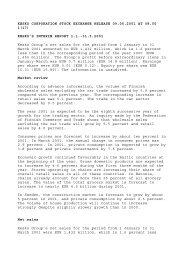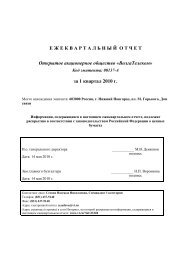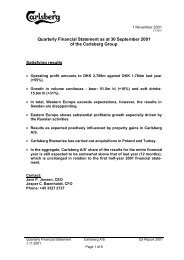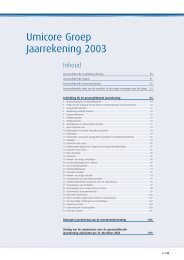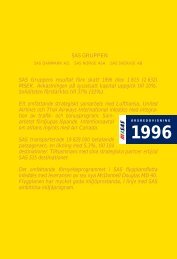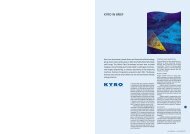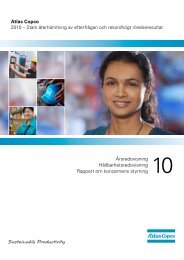össur annual report2009 - Euroland
össur annual report2009 - Euroland
össur annual report2009 - Euroland
You also want an ePaper? Increase the reach of your titles
YUMPU automatically turns print PDFs into web optimized ePapers that Google loves.
Össur hf. consolidated financial stateMents 2009<br />
or loss incorporates any dividend or interest earned on the<br />
financial asset.<br />
LOANS AND RECEIvABLES<br />
Account receivables, loans, and other receivables that<br />
have fixed or determinable payments that are not quoted<br />
in an active market are classified as loans and receivables.<br />
Loans and receivables are measured at amortised cost<br />
using the effective interest method, less any impairment.<br />
Interest income is recognised by applying the effective<br />
interest rate, except for short-term receivables when the<br />
recognition of interest would be immaterial.<br />
IMPAIRMENT OF FINANCIAL ASSETS<br />
Financial assets, other than those at FvTPL, are assessed<br />
for indicators of impairment at each balance sheet date.<br />
Financial assets are impaired where there is objective evidence<br />
that, as a result of one or more events that occurred<br />
after the initial recognition of the financial asset, the estimated<br />
future cash flows of the investment have been<br />
impacted.<br />
For certain categories of financial asset, such as account<br />
receivables, assets that are assessed not to be impaired<br />
individually are subsequently assessed for impairment on<br />
a collective basis. Objective evidence of impairment for a<br />
portfolio of receivables could include the Company’s past<br />
experience of collecting payments, an increase in the number<br />
of delayed payments in the portfolio past the companies<br />
average credit period, as well as observable changes<br />
in national or local economic conditions that correlate<br />
with default on receivables.<br />
For financial assets carried at amortised cost, the amount<br />
of the impairment is the difference between the asset’s<br />
carrying amount and the present value of estimated future<br />
cash flows, discounted at the financial asset’s original<br />
effective interest rate.<br />
<strong>annual</strong> report 09<br />
72<br />
The carrying amount of the financial asset is reduced<br />
by the impairment loss directly for all financial assets<br />
with the exception of trade receivables, where the carrying<br />
amount is reduced through the use of an allowance<br />
account. When a accounts receivable is considered uncollectible,<br />
it is written off against the allowance account.<br />
Subsequent recoveries of amounts previously written off<br />
are credited against the allowance account. Changes in the<br />
carrying amount of the allowance account are recognised<br />
in profit or loss.<br />
3.20 financial liabilities<br />
Financial liabilities are classified as either financial liabilities<br />
at ‘fair value through profit and loss’ or ‘other financial<br />
liabilities’.<br />
FINANCIAL LIABILITIES AT FAIR vALUE THROUGH PROFIT<br />
OR LOSS<br />
Financial liabilities are classified as at fair value through<br />
profit or loss when the financial liability is either held for<br />
trading or it is designated as at fair value through profit<br />
or loss.<br />
Financial liabilities at fair value through profit or loss<br />
are stated at fair value, with any gains or losses arising<br />
on remeasurement recognised in profit or loss. The net<br />
gain or loss recognised in profit or loss incorporates any<br />
interest paid on the financial liability and is included in<br />
the ‘other gains and losses’ line item in the statement of<br />
comprehensive income.<br />
OTHER FINANCIAL LIABILITIES<br />
Other financial liabilities, including borrowings, are initially<br />
measured at fair value, net of transaction costs.<br />
Other financial liabilities are subsequently measured at<br />
amortised cost using the effective interest method, with<br />
interest expense recognised on an effective yield basis.<br />
The effective interest method is a method of calculating<br />
the amortised cost of a financial liability and of allocating<br />
interest expense over the relevant period. The effective<br />
interest rate is the rate that exactly discounts estimated<br />
future cash payments through the expected life of the<br />
financial liability, or, where appropriate, a shorter period<br />
to the net carrying amount on initial recognition.<br />
DERECOGNITION OF FINANCIAL LIABILITIES<br />
The Company derecognises financial liabilities when, and<br />
only when, the Company’s obligations are discharged,<br />
cancelled or they expire.<br />
3.21 derivative financial instruMents<br />
The Company enters into a variety of derivative financial<br />
instruments to manage its exposure to interest rate and foreign<br />
exchange rate risk, including foreign exchange forward<br />
contracts and interest rate swaps. Further details of derivative<br />
financial instruments are disclosed in note 33.<br />
Derivatives are initially recognised at fair value at the date<br />
a derivative contract is entered into and are subsequently<br />
remeasured to their fair value at each balance sheet<br />
date. The resulting gain or loss is recognised in profit<br />
or loss immediately unless the derivative is designated<br />
and effective as a hedging instrument, in which event<br />
the timing of the recognition in profit or loss depends<br />
on the nature of the hedge relationship. The Company<br />
designates certain derivatives as either hedges of the fair<br />
value of recognised assets or hedges of net investments<br />
in foreign operations.



